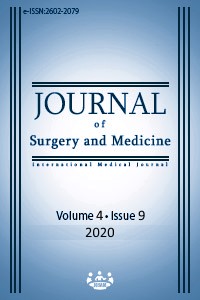Is Bethesda classification sufficient to predict thyroid cancer in endemic regions?
Keywords:
Bethesda classification, Incidental thyroid cancer, Endemic region, Thyroid noduleAbstract
Aim: Bethesda classification is widely used to determine the risk of malignancy of thyroid nodules and in many guidelines, treatment algorithms are determined according to this classification. We aimed to investigate the accuracy of malignancy predictions of Bethesda classification in patients who underwent surgery. Methods: In this retrospective cohort study, the medical records of patients who underwent thyroidectomy between 2013 and 2017 were analyzed. Patients’ demographic characteristics, fine needle aspiration biopsy (FNAB) results, ultrasonographic findings, number of nodules, diameter of nodules, type of surgeries performed, and the terminal pathology results were recorded. Malignancies that were detected in Bethesda 1-2 patients and in nodules other than the nodule to which FNAB was performed in other Bethesda categories were defined as incidental cancer. Results: Nine hundred sixty-seven patients were included in the study. The mean age of the patients was 46.9 (12.4) years and 82.4 % (n=797) were female. Mean nodule diameter was 29.7(13.9) mm and 64.3% (n=622) of the patients had 3 or more nodules. In our series, the rate of malignancy was 24.2% for Bethesda 1, 24.7% for Bethesda 2, 35 % for Bethesda 3, 52.1 % for Bethesda 4, 91.2 % for Bethesda 5 and 100 % for Bethesda 6. In all categories, the malignancy rate was higher than the expected range, but statistical significance was determined in Bethesda 1, 2, 4 and 5 groups. When compared to the whole series, rate of incidental cancer was 18.2%, whereas the incidental cancer rate was 49.5 % of all cancers. The tumor was multicentric in 34.6 % of malignant cases. Conclusion: In endemic regions, higher rates of malignancy are detected than that predicted by the Bethesda classification. Therefore, updates on guidelines in patient selection for surgery and in choosing the surgical technique may be necessary for endemic areas.
Downloads
References
Erdoğan MF. Tiroid Hastalıkları Tanı ve Tedavi Kılavuzu. Türkiye Klinikleri; 2019.
Moon JH, Hyun MK, Lee JY, Shim JI, Kim TH, Choi HS, et al. Prevalence of thyroid nodules and their associated clinical parameters: a large-scale, multicenter-based health checkup study. Korean J Intern Med. 2018 Jul;33(4):753–62.
Haugen BR, Alexander EK, Bible KC, Doherty GM, Mandel SJ, Nikiforov YE, et al. 2015 American Thyroid Association Management Guidelines for Adult Patients with Thyroid Nodules and Differentiated Thyroid Cancer: The American Thyroid Association Guidelines Task Force on Thyroid Nodules and Differentiated Thyroid Cancer. Thyroid. 2016;26(1):1–133.
Cibas ES, Ali SZ. The 2017 Bethesda System for Reporting Thyroid Cytopathology. J Am Soc Cytopathol. 2017;6(6):217–22. doi: 10.1016/j.jasc.2017.09.002
Bongiovanni M, Spitale A, Faquin WC, Mazzucchelli L, Baloch ZW. The Bethesda system for reporting thyroid cytopathology: A meta-analysis. Acta Cytol. 2012;56(4):333–9.
Ke J, Jianyong L, Ying L, Genpeng L, Linlin S, Zhihui L, et al. The use of The Bethesda System for Reporting Thyroid Cytopathology in a Chinese population: An analysis of 13,351 specimens. Diagn Cytopathol. 2019 Sep;47(9):876–80.
Kumari KA, Jadhav PD, Prasad C, Smitha NV, Jojo A, Manjula VD. Diagnostic Efficacy of Ultrasound-Guided Fine Needle Aspiration Combined with the Bethesda System of Reporting. J Cytol. 2019;36(2):101–5.
Kim M, Park HJ, Min HS, Kwon HJ, Jung CK, Chae SW, et al. The Use of the Bethesda System for Reporting Thyroid Cytopathology in Korea: A Nationwide Multicenter Survey by the Korean Society of Endocrine Pathologists. J Pathol Transl Med. 2017 Jul;51(4):410–7.
Zarif HA, Ghandurah SE, Al-Garni MA, Binmahfooz SK, Alsaywid BS, Satti MB. Thyroid Nodules Cytopathology Applying the Bethesda System with Histopathological Correlation. Saudi J Med Med Sci. 2018;6(3):143–8.
Vuong HG, Ngo HTT, Bychkov A, Jung CK, Vu TH, Lu KB, et al. Differences in surgical resection rate and risk of malignancy in thyroid cytopathology practice between Western and Asian countries: A systematic review and meta-analysis. Cancer Cytopathol. 2020 Apr;128(4):238-249. doi: 10.1002/cncy.22228.
Bradly DP, Reddy V, Prinz RA, Gattuso P. Incidental papillary carcinoma in patients treated surgically for benign thyroid diseases. Surgery. 2009;146(6):1099–104. doi: 10.1016/j.surg.2009.09.025
Evranos B, Polat SB, Cuhaci FN, Baser H, Topaloglu O, Kilicarslan A, et al. A cancer of undetermined significance: Incidental thyroid carcinoma. Diagn Cytopathol. 2019 May;47(5):412–6.
Can N, Ozyilmaz F, Celik M, Sezer AY, Sut N, Tastekin E, et al. Comparison of clinico pathological features in incidental and nonincidental papillary thyroid carcinomas in 308 patients. Polish J Pathol. 2017;68(3):197-209. doi: 10.5114/pjp.2017.71527.
Çayır D, Kulah B. Effects of preoperative fine needle aspiration biopsy on surgical strategy in patients with papillary thyroid carcinomas. J Surg Med. 2019;3(9):655-8.
Downloads
- 532 620
Published
Issue
Section
How to Cite
License
Copyright (c) 2020 Gamze Çıtlak, Bahar Canbay Torun
This work is licensed under a Creative Commons Attribution-NonCommercial-NoDerivatives 4.0 International License.
















